
|
acetic acid |
acetic acid is a lipid of Fatty Acyls (FA) class. Acetic acid is associated with abnormalities such as Vitamin B 12 Deficiency. The involved functions are known as Excretory function. The related lipids are Propionate. |
89633 |
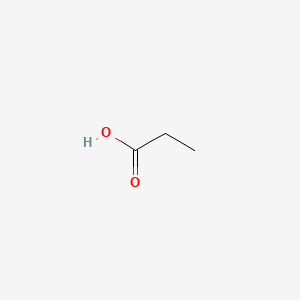
|
propionic acid |
propionic acid is a lipid of Fatty Acyls (FA) class. Propionic acid is associated with abnormalities such as Epilepsy, Infection, Tuberculosis, Alkalosis and Ischemia. The involved functions are known as Uptake, Biosynthetic Pathways, Methylation, Protein Overexpression and Biochemical Pathway. Propionic acid often locates in Body tissue, Cytoplasmic matrix, Membrane, Protoplasm and Extracellular. The associated genes with propionic acid are TRIO gene, TRRAP gene, SLC5A8 gene, SLC33A1 gene and Homologous Gene. The related lipids are Fatty Acids, Propionate, butyrate, Valerates and mycocerosic acid. |
7360 |
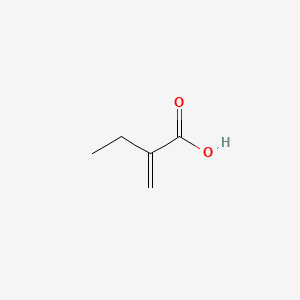
|
2-Ethylacrylic acid |
2-Ethylacrylic acid is a lipid of Fatty Acyls (FA) class. The involved functions are known as hemolysis. |
869 |

|
Arachidonic acid |
Arachidonic acid is a lipid of Fatty Acyls (FA) class. Arachidonic acid is associated with abnormalities such as Atherosclerosis, Ischemia, Hypertensive disease, Hypertension induced by pregnancy and Vascular ring of aorta. The involved functions are known as Platelet aggregation, Anabolism, Ion Transport, Signal Transduction Pathways and Signal. Arachidonic acid often locates in Extracellular, Body tissue, Protoplasm, Tissue membrane and soluble. The associated genes with Arachidonic acid are CYP2J2 gene, CYP2E1 gene, Recombinant Proteins, POR gene and P4HTM gene. The related lipids are Fatty Acids, Glycerophospholipids, Steroids, octadecadienoic acid and 9-hydroxy-10,12-octadecadienoic acid. The related experimental models are Mouse Model and Knock-out. |
22864 |

|
DHA |
Dha is a lipid of Fatty Acyls (FA) class. Dha is associated with abnormalities such as Atherosclerosis, Consumption-archaic term for TB, Chronic disease, Cardiovascular Diseases and Diabetes Mellitus, Non-Insulin-Dependent. The involved functions are known as Inflammation, Oxidation, fatty acid oxidation, Fatty Acid Metabolism and Lipid Metabolism. Dha often locates in Hepatic, Protoplasm, Mucous Membrane, Epithelium and outer membrane. The associated genes with DHA are IMPACT gene, FATE1 gene, GAPDH gene, THOC4 gene and SLC33A1 gene. The related lipids are stearidonic acid, Fatty Acids, Total cholesterol, Lipopolysaccharides and Dietary Fatty Acid. The related experimental models are Mouse Model, Transgenic Model, Animal Disease Models and Arthritis, Experimental. |
11054 |

|
Thromboxane b2 |
Thromboxane b2 is a lipid of Fatty Acyls (FA) class. Thromboxane b2 is associated with abnormalities such as endothelial dysfunction, Diabetes Mellitus, Non-Insulin-Dependent, Diabetes Mellitus, Ischemia and Thrombocytosis. The involved functions are known as Platelet Activation, Excretory function, Anabolism, Inflammation and mRNA Expression. Thromboxane b2 often locates in Endothelium, Hepatic and Microsomes, Liver. The associated genes with Thromboxane b2 are PTGS2 gene, prothrombin fragment 2 and CCL14 wt Allele. |
10175 |
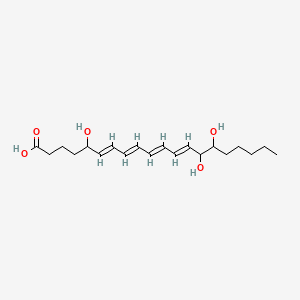
|
Lipoxin b |
Lipoxin b is a lipid of Fatty Acyls (FA) class. |
202 |
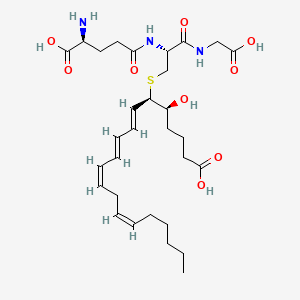
|
LTC4 |
Ltc4 is a lipid of Fatty Acyls (FA) class. Ltc4 is associated with abnormalities such as Asthma, Eosinophilia, Pulmonary Eosinophilia, Pneumonia and Cardiovascular Diseases. The involved functions are known as Signal, Gene Expression, Stimulus, Signal Transduction and Metabolic Inhibition. Ltc4 often locates in Plasma membrane, Cytoplasm, Back, Cytoplasmic and Tissue membrane. The associated genes with LTC4 are STIM1 gene, ABCC2 gene, CD9 gene, Mutant Proteins and Amino Acids, Aromatic. The related lipids are glycolithocholate. |
2252 |
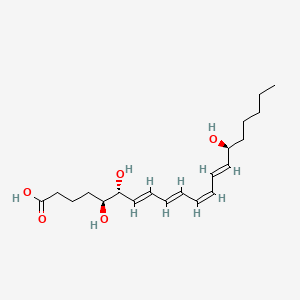
|
Lipoxin A4 |
Lipoxin a4 is a lipid of Fatty Acyls (FA) class. Lipoxin a4 is associated with abnormalities such as Asthma, Cystic Fibrosis, Pneumonia, Obesity and Septicemia. The involved functions are known as Inflammation, Signal, Signal Transduction, Regulation and Metabolic Inhibition. Lipoxin a4 often locates in Immune system, Blood, soluble, Extracellular and Splenic Tissue. The associated genes with Lipoxin A4 are FPR2 gene, Homologous Gene, SAA1 gene, Trp-Lys-Tyr-Met-Val-Met and Annexin 1. The related lipids are Steroids. The related experimental models are Knock-out. |
1240 |
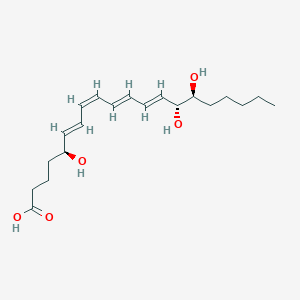
|
Lipoxin b4 |
Lipoxin b4 is a lipid of Fatty Acyls (FA) class. |
103 |
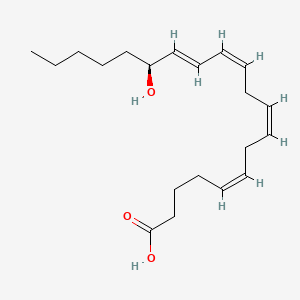
|
15S-HETE |
15s-hete is a lipid of Fatty Acyls (FA) class. 15s-hete is associated with abnormalities such as Ischemia and Vascular Diseases. The involved functions are known as Transcription, Genetic, Signal Transduction, tube formation, Angiogenic Process and Biochemical Pathway. 15s-hete often locates in Endothelium, Membrane, Cytoplasm, Body tissue and Protoplasm. The associated genes with 15S-HETE are RAC1 gene, ALOX15 gene, ALOX5 gene, Candidate Disease Gene and GAPDH gene. |
1011 |
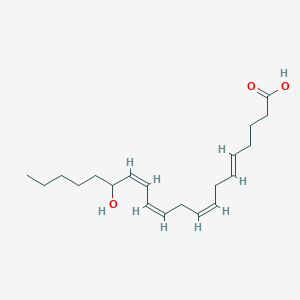
|
15-hete |
15-hete is a lipid of Fatty Acyls (FA) class. The involved functions are known as Inflammation, Signal Transduction, inhibitors, Obstruction and Adjudication. 15-hete often locates in Endothelium, Protoplasm, Cytoplasm, Cytoplasmic and Extracellular. |
725 |
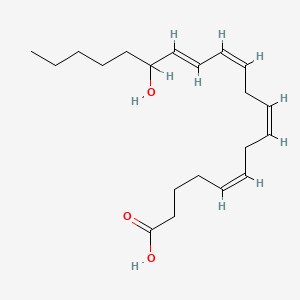
|
15-hete |
15-hete is a lipid of Fatty Acyls (FA) class. 15-hete is associated with abnormalities such as Endothelial dysfunction, Atherosclerosis, Risk factor, cardiovascular, hypercholesterolemia and Diabetes. The involved functions are known as uptake, Inflammation, Phosphorylation, Oxidation and Atherogenesis. 15-hete often locates in Endothelium, Cell surface, Protoplasm, Body tissue and Blood. The associated genes with 15-hete are CD36 gene, CCL2 gene, Orthologous Gene, SMAD2 gene and SMAD3 gene. The related lipids are 9-hydroxy-10,12-octadecadienoic acid and hydroxy fatty acid. |
725 |
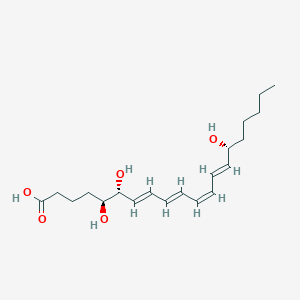
|
15-epi-lxa4;15r-lxa4 |
15-epi-lxa4;15r-lxa4 is a lipid of Fatty Acyls (FA) class. 15-epi-lxa4;15r-lxa4 is associated with abnormalities such as Pneumonia, Septicemia, Cystic Fibrosis, Subarachnoid Hemorrhage and Obesity. The involved functions are known as Protective Agents, Signal Transduction, cytokine biosynthesis, Inflammation and Anabolism. 15-epi-lxa4;15r-lxa4 often locates in Blood, Immune system and Heart tissue. The associated genes with 15-epi-lxa4;15r-lxa4 are IL2 gene, CXCL13 gene and CMKLR1 gene. The related lipids are Steroids. The related experimental models are Knock-out. |
305 |

|
Lipoic acid |
Lipoic acid is a lipid of Fatty Acyls (FA) class. |
7940 |

|
17(18)-EpETE |
17(18)-epete is a lipid of Fatty Acyls (FA) class. |
28 |

|
Prostaglandin E2 |
Prostaglandin E2 is a lipid of Fatty Acyls (FA) class. Prostaglandin e2 is associated with abnormalities such as Renal glomerular disease, Arthritis, Degenerative polyarthritis, Pancreatitis and Rheumatoid Arthritis. The involved functions are known as enzyme pathway, Atherogenesis, Anabolism, inhibitors and Oxidants. Prostaglandin e2 often locates in Tissue membrane, Blood, Extracellular, Membrane and Protoplasm. The associated genes with Prostaglandin E2 are PTGS2 gene, TP53 gene, TNFRSF5 gene, FASTK Gene and TNF gene. The related lipids are Lipopolysaccharides, Steroids, monooxyethylene trimethylolpropane tristearate, Fatty Acids, Unsaturated and Promega. The related experimental models are Arthritis, Adjuvant-Induced, Xenograft Model, Experimental Autoimmune Encephalomyelitis, Cancer Model and Knock-out. |
49278 |

|
PGD2 |
Pgd2 is a lipid of Fatty Acyls (FA) class. Pgd2 is associated with abnormalities such as Inflammatory disorder, Pleurisy, Rhinitis, Dehydration and Pneumonia. The involved functions are known as antagonists, fat cell differentiation, Phosphorylation, Process and Gene Expression. Pgd2 often locates in Cell surface, Body tissue, Extracellular, Bone Marrow and Membrane. The associated genes with PGD2 are oxytocin, 1-desamino-(O-Et-Tyr)(2)-, P4HTM gene, PTGS2 gene, PTGDS gene and IL3 gene. The related lipids are 15-deoxyprostaglandin J2, Nonesterified Fatty Acids, Lipopolysaccharides, Steroids and Liposomes. The related experimental models are Knock-out and Rodent Model. |
6464 |

|
11beta-PGF2 |
11beta-pgf2 is a lipid of Fatty Acyls (FA) class. |
15009 |
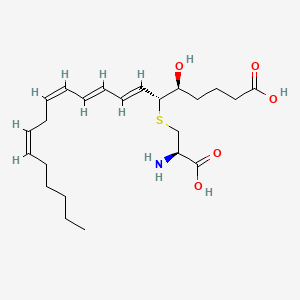
|
LTE4 |
Lte4 is a lipid of Fatty Acyls (FA) class. Lte4 is associated with abnormalities such as Asthma, Lung diseases, Eosinophilia, Respiration Disorders and Rhinitis. The involved functions are known as Anabolism, Increased Sensitivy, Process, Pathogenesis and Stimulus. Lte4 often locates in Membrane, Smooth muscle (tissue), Body tissue, Extracellular and Mucous Membrane. The associated genes with LTE4 are cystinylglycylglycine, FPR1 gene, PECAM1 gene, CCL3L1 gene and IL3 gene. |
1546 |
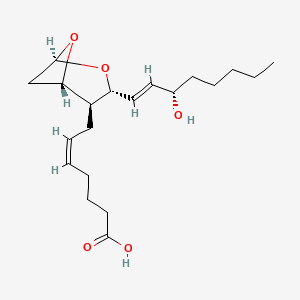
|
Thromboxane a2 |
Thromboxane a2 is a lipid of Fatty Acyls (FA) class. Thromboxane a2 is associated with abnormalities such as Asthma, Cardiovascular Diseases, Pulmonary Eosinophilia, ASPIRIN SENSITIVITY and Pneumonia. The involved functions are known as Signal Transduction, paracrine, Binding (Molecular Function), Platelet Activation and Inflammation. Thromboxane a2 often locates in Cell surface, Body tissue, Cell membrane, Blood and Extracellular. The associated genes with Thromboxane a2 are PTPRC gene, ESAM gene and PPBP gene. |
4534 |
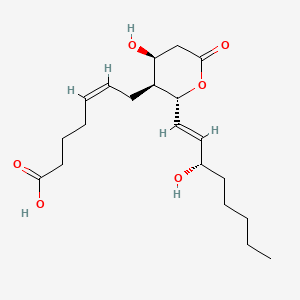
|
11-dehydro-TXB2 |
11-dehydro-txb2 is a lipid of Fatty Acyls (FA) class. 11-dehydro-txb2 is associated with abnormalities such as endothelial dysfunction, Risk factor, cardiovascular, Acute coronary syndrome, thrombocytosis and Chronic ischemic heart disease NOS. The involved functions are known as Platelet Activation, Excretory function, Anabolism, Inflammation and Lipid Peroxidation. The associated genes with 11-dehydro-TXB2 are PTGS2 gene. |
381 |
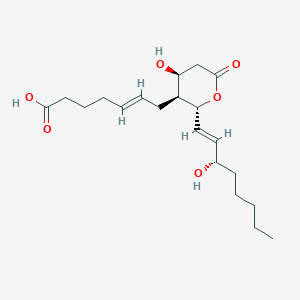
|
11-dehydro-txb2 |
|
98 |

|
Leukotriene b4 |
Leukotriene b4 is a lipid of Fatty Acyls (FA) class. The involved functions are known as Chemotaxis, release of sequestered calcium ion into cytoplasm and Polymerization. Leukotriene b4 often locates in Protoplasm. The associated genes with Leukotriene b4 are phallacidin. |
9311 |
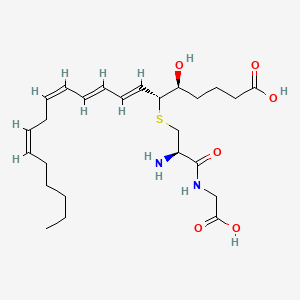
|
LTD4 |
Ltd4 is a lipid of Fatty Acyls (FA) class. Ltd4 is associated with abnormalities such as Inflammatory Bowel Diseases, Inflammatory disorder, Asthma, Pneumonia and Allergic asthma. The involved functions are known as inhibitors, Signal Transduction, Cell Survival, antagonists and Phosphorylation. Ltd4 often locates in Membrane, Tissue membrane, Protoplasm, Cytoplasmic matrix and membrane fraction. The associated genes with LTD4 are ALOX5 gene, UMOD gene, P4HTM gene, RAF1 gene and Homologous Gene. The related lipids are Lipopolysaccharides. |
1167 |
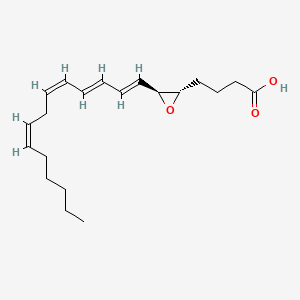
|
LTA4 |
Lta4 is a lipid of Fatty Acyls (FA) class. Lta4 is associated with abnormalities such as Myocardial Infarction. The involved functions are known as enzyme activity, Mutation, Lipid Binding, Neutrophil Activation and Inflammation. Lta4 often locates in Membrane, Extracellular and Cytosol. The associated genes with LTA4 are Locus, ALOX5AP gene, CIITA gene and TNFSF4 gene. The related lipids are Lipopolysaccharides. |
526 |
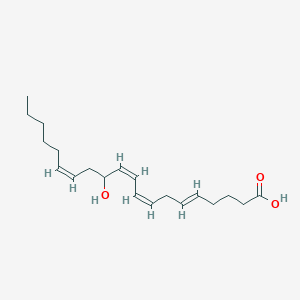
|
12-hete |
12-hete is a lipid of Fatty Acyls (FA) class. |
1452 |
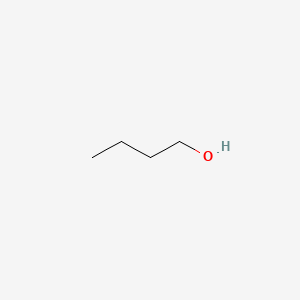
|
1-butanol |
1-butanol is a lipid of Fatty Acyls (FA) class. |
5925 |

|
Hexane |
Hexane is a lipid of Fatty Acyls (FA) class. |
9183 |

|
Platelet activating factor |
Platelet activating factor is a lipid of Glycerophospholipids (GP) class. Platelet activating factor is associated with abnormalities such as Atherosclerosis, Acute cholecystitis without calculus, Cholecystitis, Colitis and Cholecystitis, Acute. The involved functions are known as Cell Survival, Metabolic Inhibition, lipid oxidation, Apoptosis and Oxidation. Platelet activating factor often locates in soluble, Cellular Membrane, Smooth muscle (tissue), Intima and Tissue specimen. The associated genes with Platelet activating factor are apolipoprotein A-I Milano, Homologous Gene, TSPO gene, HBEGF gene and SLC33A1 gene. The related lipids are Hydroxycholesterols, Liposomes, 25-hydroxycholesterol, Lysophosphatidylcholines and Lipopolysaccharides. The related experimental models are Knock-out, Mouse Model and Transgenic Model. |
7383 |

|
1-Oleoyl Lysophosphatidic Acid |
1-Oleoyl Lysophosphatidic Acid is a lipid of Glycerophospholipids (GP) class. 1-oleoyl lysophosphatidic acid is associated with abnormalities such as Myocardial Infarction, early pregnancy, Scleroderma, Blind Vision and Hyperlipidemia. The involved functions are known as Agent, Blood coagulation, Selection, Genetic, Analyte and Biological Processes. 1-oleoyl lysophosphatidic acid often locates in Tissue specimen, Body tissue, Blood, Membrane and Skin. The associated genes with 1-Oleoyl Lysophosphatidic Acid are Mucin-16, Peptides, SMAD4 gene, RND1 gene and Polypeptides. The related lipids are lysophosphatidic acid, A(2)C, Lysophospholipids, Fatty Acids and sphingosine 1-phosphate. The related experimental models are Mouse Model, Knock-out, Cancer Model, Xenograft Model and Arthritis, Adjuvant-Induced. |
3463 |

|
lysophosphatidic acid |
lysophosphatidic acid is a lipid of Glycerophospholipids (GP) class. Lysophosphatidic acid is associated with abnormalities such as Atherosclerosis, Alzheimer's Disease, Asthma, Diabetes Mellitus, Non-Insulin-Dependent and Septicemia. The involved functions are known as Inflammation, Chemotaxis, Binding (Molecular Function), Polymerization and Inflammatory Response. Lysophosphatidic acid often locates in Cytoskeleton, Microfilaments, actin cytoskeleton, Extracellular and Structure of germinal center of lymph node. The associated genes with lysophosphatidic acid are TNF gene, MAPK3 gene, RHOA gene, CDC42 gene and ADRBK1 gene. The related lipids are lysophosphatidic acid, Lipopolysaccharides, Lysophosphatidylcholines, Lysophospholipids and Phosphatidic Acid. The related experimental models are Knock-out, Transgenic Model, Rodent Model and Disease model. |
820 |

|
trichostatin A |
Trichostatin is a lipid of Polyketides (PK) class. Trichostatin is associated with abnormalities such as Dentatorubral-Pallidoluysian Atrophy, PARAGANGLIOMAS 3, abnormal fragmented structure, Disintegration (morphologic abnormality) and Hyperostosis, Diffuse Idiopathic Skeletal. The involved functions are known as Acetylation, Cell Differentiation process, histone modification, Gene Silencing and Transcriptional Activation. Trichostatin often locates in CD41a, Hematopoietic System, Chromatin Structure, Blood and Endothelium. The associated genes with Trichostatin are SPI1 gene, CELL Gene, Chromatin, CXCR4 gene and DNMT1 gene. The related lipids are Butyrates, Promega, butyrate, Lipopolysaccharides and Steroids. The related experimental models are Knock-out, Mouse Model, Xenograft Model and Cancer Model. |
5401 |
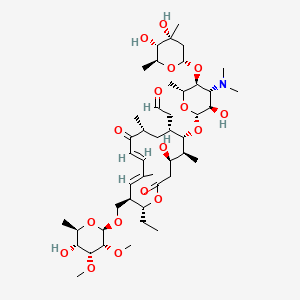
|
Tylosin |
Tylosin is a lipid of Polyketides (PK) class. Tylosin is associated with abnormalities such as Mastitis, Bovine, Infection, Bacterial Infections, Arthritis and Ileitis. The involved functions are known as Anabolism, acireductone dioxygenase [iron(II)-requiring] activity, Protein Biosynthesis, Mastitis and Methylation. Tylosin often locates in Ribosomes, Cell Wall, 50S ribosomal subunit, Ribosome Subunits, Large and Ribosome Subunits. The associated genes with Tylosin are Gene Clusters, Genome, resistance genes, Homologous Gene and HM13 gene. The related experimental models are Knock-out. |
1035 |
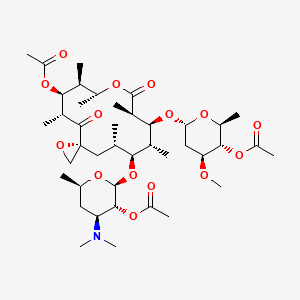
|
TROLEANDOMYCIN |
TROLEANDOMYCIN is a lipid of Polyketides (PK) class. Troleandomycin is associated with abnormalities such as Xanthomatosis, Cerebrotendinous and Jaundice, Obstructive. The involved functions are known as Binding (Molecular Function), Anabolism, hydroxylase activity, Oxidation and immunoreactivity. Troleandomycin often locates in Microsomes, Liver, Human tissue, Microsomes, Hepatic and Immune system. The associated genes with TROLEANDOMYCIN are CYP3A5 gene, CYP3A7 gene, CYP2D6 gene, P4HTM gene and CYP2C19 gene. The related lipids are Androstenes, androstan-17-one, 25-hydroxycholesterol, Sterols and 4-hydroxycholesterol. |
948 |

|
minocycline |
minocycline is a lipid of Polyketides (PK) class. Minocycline is associated with abnormalities such as Infection, Soft Tissue Infections, Septicemia, Chronic hyponatremia and Lesion of brain. The involved functions are known as Pharmacodynamics, Gene Expression, Transcriptional Activation, Regulation and Process. Minocycline often locates in Ribosomes, 50S ribosomal subunit, Blood, Skin and Immune system. The associated genes with minocycline are THEMIS gene, KCNK2 gene, RBFOX3 gene, PIWIL2 gene and P4HTM gene. The related lipids are Lipopolysaccharides, Promega, Steroids, Liposomes and Octanols. The related experimental models are Mouse Model, Experimental Autoimmune Encephalomyelitis, Genetically Engineered Mouse, Disease model and spinal model. |
9780 |

|
CYTOCHALASIN B |
CYTOCHALASIN B is a lipid of Polyketides (PK) class. Cytochalasin b is associated with abnormalities such as Renal tubular disorder and Chagas Disease. The involved functions are known as Membrane Protein Traffic, inhibitors, Metabolic Inhibition, Biochemical Pathway and Increased Sensitivy. Cytochalasin b often locates in Cytoplasmic matrix, Plasma membrane, Microtubules, Extracellular and Protoplasm. The associated genes with CYTOCHALASIN B are SLC2A2 gene, PFDN5 gene, SLC2A1 gene, OMG gene and SPEN gene. The related lipids are Steroids, Lipopolysaccharides and Liposomes. The related experimental models are Xenograft Model. |
9648 |

|
(-)-Epigallocatechin gallate |
(-)-Epigallocatechin gallate is a lipid of Polyketides (PK) class. (-)-epigallocatechin gallate is associated with abnormalities such as IMMUNE SUPPRESSION, Infection, Nodule, Lymphopenia and Tumor Immunity. The involved functions are known as Apoptosis, Cellular Immune Response, Specific immune response, Signal and Infiltration. (-)-epigallocatechin gallate often locates in Immune system, Cytoplasmic Granules, Skin, Protoplasm and Body tissue. The associated genes with (-)-Epigallocatechin gallate are C8orf4 gene, Genes, vpr, MAPK8 gene, P4HTM gene and GAG Gene. The related lipids are Promega, Lipopolysaccharides, Palmitates, Fatty Acids and Sphingolipids. The related experimental models are Mouse Model, Xenograft Model, Transgenic Model, Experimental Autoimmune Encephalomyelitis and Arthritis, Collagen-Induced. |
6551 |

|
quercetin |
quercetin is a lipid of Polyketides (PK) class. Quercetin is associated with abnormalities such as Coronary heart disease, Myocardial Infarction, Cirrhosis, Coronary Arteriosclerosis and Vascular ring. The involved functions are known as Vasodilation, physiological aspects, Fermentation, Process and Ingredient. Quercetin often locates in Arterial system, Endothelium, Skin, Endothelium, Vascular and Tissue specimen. The associated genes with quercetin are P4HTM gene, SULT gene, UGT1A1 gene, ARHGAP26 gene and PLXNB1 gene. The related lipids are blood lipid, Promega, Steroids, Phosphatidylserines and Fatty Acids. The related experimental models are Knock-out, Mouse Model, Xenograft Model, Tissue Model and Cancer Model. |
5377 |

|
apigenin |
apigenin is a lipid of Polyketides (PK) class. Apigenin is associated with abnormalities such as Morphologically altered structure, Chimera disorder, Hypertensive disease, infection induced and Infection. The involved functions are known as inhibitors, Gene Expression, Process, Metabolic Inhibition and Cell Death. Apigenin often locates in Vacuole, Cytoplasmic matrix, Cytoplasm, Tissue membrane and Membrane. The associated genes with apigenin are MSMP gene, BCL2 gene, PTGS2 gene, Chromatin and SLC33A1 gene. The related lipids are Lipopolysaccharides, Steroids, 1-Butanol, agosterol A and Butyrates. The related experimental models are Mouse Model, Tissue Model, Knock-out, Xenograft Model and Disease model. |
4250 |

|
luteolin |
luteolin is a lipid of Polyketides (PK) class. Luteolin is associated with abnormalities such as Morphologically altered structure, Nodule, retinal toxicity, CLEFT LIP, CONGENITAL HEALED and Ischemia. The involved functions are known as Metabolic Inhibition, Cell Death, Caspase Activation, activation of protein kinase C activity by G-protein coupled receptor protein signaling pathway and protein kinase C activity. Luteolin often locates in Mitochondria, Cell-Free System, Protoplasm, Membrane and Body tissue. The associated genes with luteolin are BCL2 gene, TNFSF10 gene, BCL2L1 gene, XIAP gene and MCL1 gene. The related lipids are Lipopolysaccharides, Sterols, blood lipid, Fatty Acids and Steroids. The related experimental models are Xenograft Model, Mouse Model, Experimental Autoimmune Encephalomyelitis, Knock-out and Cancer Model. |
3284 |

|
FLAVONE |
FLAVONE is a lipid of Polyketides (PK) class. Flavone is associated with abnormalities such as Cardiovascular Diseases, Cerebrovascular accident, DERMATITIS HERPETIFORMIS, FAMILIAL, Hyperinsulinism and Inflammatory disorder. The involved functions are known as Oxidation-Reduction, Metabolic Inhibition, Inflammation, Phosphorylation and antioxidant activity. Flavone often locates in Endothelium, Hepatic, Protoplasm, Body tissue and Extracellular. The associated genes with FLAVONE are ICAM1 gene, BCL2L1 gene, MYC gene, TP53 gene and cytochrome c''. The related lipids are Promega, Steroids and Total cholesterol. The related experimental models are Knock-out, Disease model and Animal Disease Models. |
2093 |

|
baicalein |
baicalein is a lipid of Polyketides (PK) class. Baicalein is associated with abnormalities such as Neurodegenerative Disorders, Fibrillation, Hypertensive disease, Aortic coarctation and Coronary Occlusion. The involved functions are known as Anabolism, Polymerization, Process, inhibitors and Pathogenesis. Baicalein often locates in Membrane, Lipid Bilayers, soluble, Cell-Free System and Protoplasm. The associated genes with baicalein are P4HTM gene, BIRC5 gene, TSPO gene, SHOC2 gene and XIAP gene. The related lipids are Fatty Acids, Nonesterified Fatty Acids, iodoresiniferatoxin, Lipopolysaccharides and 17-octadecynoic acid. The related experimental models are Knock-out, Mouse Model and Parkinsonism, Experimental. |
1997 |
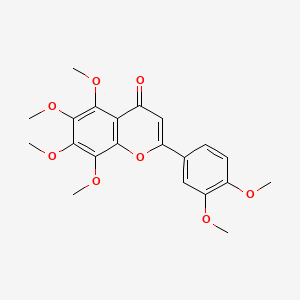
|
Nobiletin |
Nobiletin is a lipid of Polyketides (PK) class. Nobiletin is associated with abnormalities such as Hashimoto Disease, nervous system disorder, Dermatitis, Senile Plaques and Metabolic Diseases. The involved functions are known as 5-(carboxyamino)imidazole ribonucleotide mutase activity, Signal Transduction, Biochemical Pathway, Phosphorylation and MAP kinase kinase activity. Nobiletin often locates in Extracellular, Protoplasm, Back, Mouse Skin and Skin - Epidermis (MMHCC). The associated genes with Nobiletin are MAP2K1 gene, PTGS2 gene, Amyloid beta-Protein Precursor, Candidate Disease Gene and BCL2 gene. The related lipids are Lipopolysaccharides and Sterols. The related experimental models are Mouse Model and Transgenic Model. |
550 |
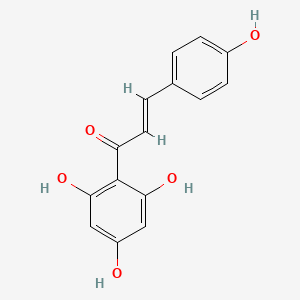
|
naringenin chalcone |
Naringenin chalcone is a lipid of Polyketides (PK) class. Naringenin chalcone is associated with abnormalities such as Dental caries. The involved functions are known as Anabolism, ripening, Localized desquamation, Mutation and gene induction. Naringenin chalcone often locates in Epidermis. The associated genes with Naringenin chalcone are Candidate Disease Gene, Homologous Gene, SLC7A2 gene and CAT 1.6.1. |
57 |
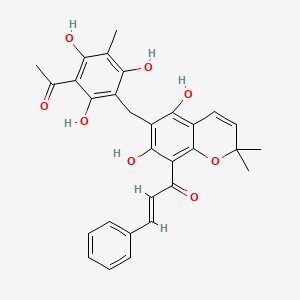
|
rottlerin |
Rottlerin is a lipid of Polyketides (PK) class. Rottlerin is associated with abnormalities such as PARAGANGLIOMAS 2, Hyperostosis, Diffuse Idiopathic Skeletal, Virus Diseases, Perisylvian syndrome and Autoimmune disease (systemic) NOS. The involved functions are known as Apoptosis, Regulation, Signal Transduction, inhibitors and Proteasome Inhibitors [MoA]. Rottlerin often locates in Clone, Membrane, Body tissue, Plasma membrane and soluble. The associated genes with Rottlerin are XIAP gene, GAPDH gene, ICAM1 gene, P4HTM gene and TNFSF10 gene. The related lipids are Promega, Fatty Acids, Sphingolipids, Lipopolysaccharides and Saponin. The related experimental models are Mouse Model, Xenograft Model and Cancer Model. |
1198 |
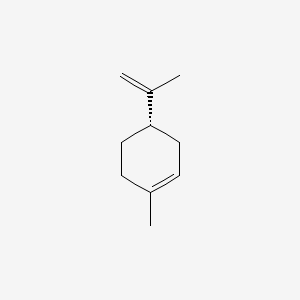
|
(-)-Limonene |
(-)-limonene is a lipid of Prenol Lipids (PR) class. (-)-limonene often locates in Kinetochores. |
1786 |
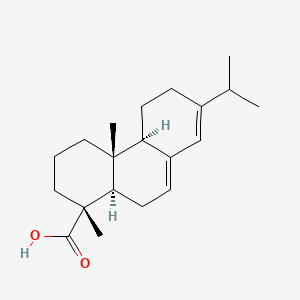
|
Abietic acid |
Abietic acid is a lipid of Prenol Lipids (PR) class. Abietic acid is associated with abnormalities such as Hand eczema, Dermatitis, Vitelliform dystrophy, Wiskott-Aldrich Syndrome and Dehydration. The involved functions are known as Process, Oxidation, Anabolism, Transmembrane Transport and physiological aspects. Abietic acid often locates in Membrane, Protoplasm, Microsomes and Cellular Membrane. The associated genes with Abietic acid are SLC33A1 gene and ABCG2 gene. The related lipids are Pinene. |
280 |

|
Sphingosine 1-phosphate |
Sphingosine 1-phosphate is a lipid of Sphingolipids (SP) class. Sphingosine 1-phosphate is associated with abnormalities such as Infection, Painful Bladder Syndrome, Atherosclerosis, Hyperglycemia and Rheumatoid Arthritis. The involved functions are known as Phosphorylation, Regulation, enzyme activity, Energy Absorption and Vascular Permeability. Sphingosine 1-phosphate often locates in Endothelium, Tissue membrane, Vascular System, Protoplasm and Microfilaments. The associated genes with Sphingosine 1-phosphate are MBTPS1 gene, FBXL15 gene, TEK gene, NTRK1 gene and Gene Family. The related lipids are Promega, Lipopolysaccharides, lysophosphatidic acid, Lysophosphatidylcholines and Lysophospholipids. The related experimental models are Knock-out, Mouse Model, Transgenic Model, Disease model and Experimental Autoimmune Encephalomyelitis. |
2005 |
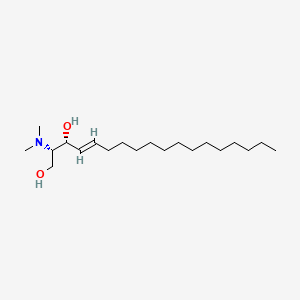
|
N,N-dimethylsphingosine |
N,N-dimethylsphingosine is a lipid of Sphingolipids (SP) class. N,n-dimethylsphingosine is associated with abnormalities such as Exanthema and Increased drug resistance. The involved functions are known as Vmax, Metabolic Inhibition, Anabolism, Binding (Molecular Function) and Cytokinesis. N,n-dimethylsphingosine often locates in yolk, Membrane, CNS - Brain (MMHCC), soluble and Tissue membrane. The associated genes with N,N-dimethylsphingosine are FPR1 gene, ANP32A gene, HPGDS gene, Nuclear phosphoprotein and PTGS2 gene. The related lipids are Sphingolipids, Phosphatidic Acid, Lysophosphatidylcholines, stearylamine and dihydroceramide. The related experimental models are Mouse Model and Knock-out. |
151 |
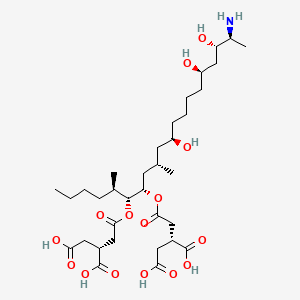
|
fumonisin b1 |
fumonisin b1 is a lipid of Sphingolipids (SP) class. Fumonisin b1 is associated with abnormalities such as Infection, Kidney Diseases, Liver diseases, DERMATITIS HERPETIFORMIS, FAMILIAL and Malnutrition. The involved functions are known as Gene Expression, Anabolism, Signal, Biosynthetic Pathways and Regulation. Fumonisin b1 often locates in Body tissue, Microsomes, microsomal membrane, Protoplasm and Mitochondria. The associated genes with fumonisin b1 are Genome, P4HTM gene, FATE1 gene, BCL2 gene and TMEM132D gene. The related lipids are dihydroceramide, ceramide 1-phosphate, Sphingolipids, Fatty Acids and Palmitates. |
902 |

|
cholesterol |
cholesterol is a lipid of Sterol Lipids (ST) class. Cholesterol is associated with abnormalities such as Trypanosomiasis, Chagas Disease, Cleft Palate, Chondrodysplasia punctata 2, X-linked dominant and Child syndrome. The involved functions are known as Blood Circulation, Sterol Biosynthesis Pathway, Receptor Mediated Endocytosis, Methylation and Signal. Cholesterol often locates in Animal tissue, Blood, Membrane, Plasma membrane and peroxisome. The associated genes with cholesterol are MBD2 gene, SIM, SLC33A1 gene, Genome and NSDHL gene. The related lipids are Sterols, zymosterol, fecosterol, Total cholesterol and 7-dehydrocholesterol. The related experimental models are Mouse Model, Knock-out, Genetically Engineered Mouse and Disease model. |
98461 |



















































